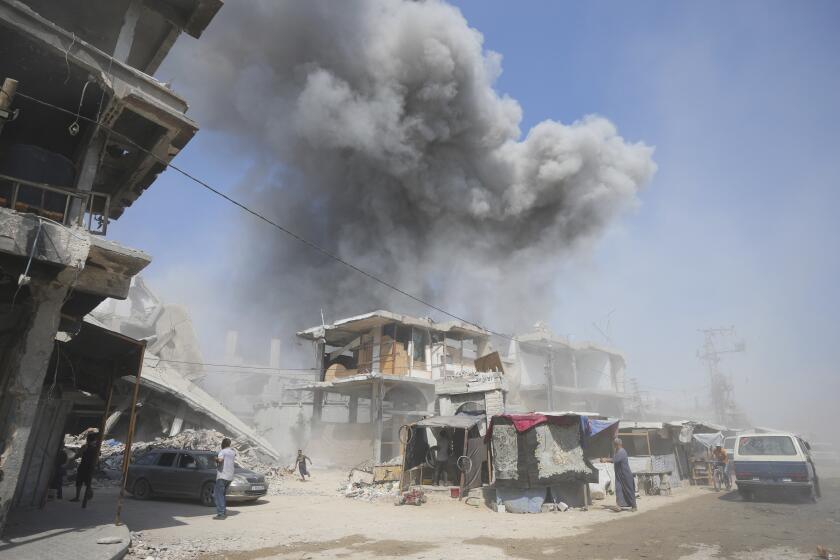The Last Days of Bamian’s Buddhas
It took decades to build the magnificent stone Buddhas of Bamian. It took the Taliban nearly a month to obliterate them.
The destruction required an extraordinary effort, so complex that foreign explosives experts had to be brought in and local residents were forced to dangle on ropes over a cliff face to chip out holes for explosives. According to witnesses and participants, the Taliban struggled with ropes and pulleys, rockets, iron rods, jackhammers, artillery and tanks before a series of massive explosions finally toppled the statues.
“Every day these Talibs tried to destroy the Buddhas, and every day the Buddhas remained standing no matter how hard the Taliban tried,” said Ahmad Hussein, 55, a Bamian native who said he watched the statues slowly disintegrate over a 26-day period last February and March.
The broad outlines of the destruction have been reported. But the ethnic Hazara villagers who witnessed the siege or were pressed into service have provided new details of how the Buddhas, which had survived for more than 1,600 years, withstood repeated Taliban assaults before succumbing.
After point-blank artillery and tank fire gouged holes in the statues but left them essentially intact, the Taliban planted a row of explosives at the feet of the taller Buddha, the 175-foot statue known as Solsol, which means “year after year.” The 20 timed explosions merely blew off part of the statue’s feet, residents said, but they destroyed the adobe-and-wood Fatha mosque at the base of the sandstone cliff from which the Buddha was hewn.
Realizing that more expertise was needed, the Taliban summoned two Pakistani and two Arab explosives experts who residents say were provided by Osama bin Laden’s Al Qaeda network. It was then that Hazaras, the Shiite Muslim residents of the region who were killed and persecuted under the Taliban’s Sunni Muslim rule, were forced to suspend themselves from the cliffs to carve out cavities for explosives.
Ali Agha, a wiry man of 28, said he worked for a Taliban group that called itself Sipah-e-Sahaba, or Guardians of the Friends of the Prophet. Reaching a niche behind the Buddha’s head by climbing steps cut into the rock face, the Hazaras were lowered on ropes held by 12 men each.
Dangling off the sheer cliff face, supported by thin ropes that frayed as they wore against the sandstone, the Hazaras chipped away with tire irons, chisels and sharpened steel rods, Agha said.
“We got dizzy from the height, and they pulled us up and beat us with their gun butts,” Agha said. “If we didn’t work fast enough, they threw stones at us and called us Hazara bastards.”
The Hazaras had been kidnapped by Taliban forces that had burned and ransacked their villages, the residents said. They had been digging foxholes for the Taliban when they were dragooned into demolishing the statues. “We worked all day, and they didn’t even give us lunch,” Agha complained.
Agha managed to gouge out a hole in the smaller Buddha’s left shoulder after eight hours, he said. A Pakistani explosives expert who was lowered on an elaborate pulley system rigged with safety harnesses planted explosives in the cavity.
The Taliban also forced the men to haul a jackhammer to the top of the smaller Buddha to pound out holes for explosives, residents said.
Through it all, the witnesses said, a senior Taliban official was ferried in by helicopter every few days to supervise the demolition and demand that local Taliban leaders find more efficient ways to destroy the Buddhas.
“I don’t know his name, but he was a dog,” said one Hazara elder, Said Mohammed, 47, who lives in one of the caves in the Buddha cliffs.
Other villagers said the official was the Taliban defense minister, Mullah Obaidulla. They said he was one of several important Taliban members who appeared from time to time to witness the destruction and deliver progress reports to senior Taliban leaders in Kandahar and Kabul.
The Taliban began by attempting to obliterate traces of breasts on the smaller, 120-foot Buddha known as Shahmama, or “king mother.” The original breasts had worn away but a slight bulge remained, residents said.
The destruction was ordered in February 2001 by Taliban leader Mullah Mohammed Omar, who called the Buddhas “idolatrous,” “false idols” and “gods of the infidels,” the latter a reference to the Hazaras. Under its extreme interpretation of the Koran, the Taliban outlawed the depiction of any living thing.
Today, an inscription from the Koran, spray-painted by Taliban members beside the larger Buddha’s alcove, reads: “The just replaces the unjust.”
The statues, built between the 3rd and 5th centuries, represented a classic fusion of Buddhist and Grecian art. They were erected before the Hazaras converted in the 9th century from Buddhism to Shiite Islam. Located along the Silk Road, on which camel caravans plodded between China and Rome, the Buddhas survived attacks by Genghis Khan and others.
The Taliban was so thorough that it destroyed smaller statues and frescoes in the niches behind the Buddhas. Several residents said the Taliban removed some frescoes and small statues before the demolition began and trucked them to Pakistan to sell. Karim Khalili, the Hazara warlord in Bamian province, along with Western aid officials here, said they had heard such claims but could not verify them.
Day after day, residents said, the valley was smothered in smoke and dust, first from artillery and tank fire, then from the explosives. They said the blasts toppled the walls of adobe homes on the dirt track below the cliffs and shattered windows in a bazaar a mile away.
“It didn’t happen all at once,” said Hussein, the Bamian native. “It was little by little, day by day. They tried 50 artillery rounds, 100 tank rounds, and they only made small holes. Then there were explosions, so many every day.”
After failing to topple the larger Buddha by attacking the legs, the Taliban began taking the statue down from the top. Residents said the explosions took off the head and shoulders, but metal support rods set into the torso in the 1930s slowed the demolition.
For the final, massive explosions, the Taliban forced Hazaras from their homes in the valley. Those who resisted were imprisoned or killed, residents said. Many fled to a plateau across the valley, near what is now a U.S. Special Forces compound.
They watched the Buddha’s torso crumple, and then his flowing robes and finally his sturdy legs and feet.
Afterward, they said, the Taliban members celebrated and taunted the Hazaras. “They told us: ‘We have killed your gods,’ ” said Mohammed, the Hazara elder.
The Taliban regime was not the first to deface the site. Muslims of the first millennium, seeking to kill the souls of idols, gouged out the faces of small Buddhas painted inside the niches.
The Taliban photographed and videotaped the destruction of the statues. It distributed a celebratory calendar showing tank and rocket fire exploding into the Buddhas. The calendar, which boasts that 137,500 pounds of explosives were used, is titled: “The greatest historical sight the destruction of the statues of Bamian.”
Today, shrapnel and spent rocket casings are scattered amid the dusty debris below the alcoves.
It is possible to climb the narrow stone steps to the niches carved above the smaller Buddha’s head. Sections of frescoes somehow survived, with traces of pastel blue, sienna and yellow ochre. The view is breathtaking: crimson and gold cliffs across the valley and the majestic gray Hindu Kush mountains beyond.
Within the alcove of the larger Buddha, steel rods still protrude from the cliff face. Huge chunks of the statue lay at the base of the cliff. They were covered with fiberglass protective sheeting in December by a team of archeologists sponsored by the United Nations Educational, Scientific and Cultural Organization.
The U.N. agency has convened a panel of experts to consider an Afghan government request to rebuild or replace the Buddhas. Among the possibilities are replicating the statutes on the same site or building similar Buddhas nearby, said Peter Maxwell, a U.N. official in Bamian.
The Hazaras say they did not worship the Buddhas, or consider them gods. But they were priceless symbols of the Hazara people, who regret that they could not save the statues.
“We loved our Buddhas very much,” Hussein said.
Khalili, the warlord who led Hazara fighters back into Bamian last fall, cannot avoid seeing the yawning Buddha alcoves from the front gate of his military headquarters in the valley a mile away. It is a painful thing.
“Of course it hurts,” Khalili said. “These statues were a great source of pride for the Hazara people.”
As the warlord spoke, his voice softened and he lowered his eyes at the mention of the great Buddhas. Behind him, the sun rose and cast sharp shadows across the empty alcoves, timeless and eternal.
More to Read
Sign up for Essential California
The most important California stories and recommendations in your inbox every morning.
You may occasionally receive promotional content from the Los Angeles Times.







